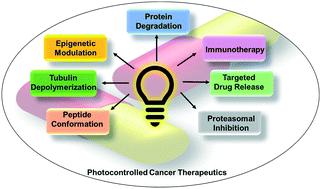当前位置:
X-MOL 学术
›
RSC Med. Chem.
›
论文详情
Our official English website, www.x-mol.net, welcomes your
feedback! (Note: you will need to create a separate account there.)
Photocontrolled activation of small molecule cancer therapeutics
RSC Medicinal Chemistry ( IF 4.1 ) Pub Date : 2020-07-31 , DOI: 10.1039/d0md00107d M Michael Dcona 1, 2 , Koushambi Mitra 2, 3 , Matthew C T Hartman 2, 3
RSC Medicinal Chemistry ( IF 4.1 ) Pub Date : 2020-07-31 , DOI: 10.1039/d0md00107d M Michael Dcona 1, 2 , Koushambi Mitra 2, 3 , Matthew C T Hartman 2, 3
Affiliation

|
Cancer remains one of the leading causes of death worldwide. Conventional treatment of the disease is comprised of chemotherapy, radiation and surgery among other treatment approaches. Chemotherapy is plagued by multiple side-effects caused due to non-specific drug action. Light-based therapies offer an alternative treatment approach that can be fine tuned to achieve the desired effect to treat the disease and address challenges posed by chemotherapeutic side-effects. Photodynamic therapy (PDT) is one of the light mediated treatment modalities that has been successfully applied to treat superficial malignancies with high-efficiency, although its dependence on normoxic conditions limits its efficiency to treat deep-seated tumors. On the other hand, light-sensitive drug-mimetics and drug-release platforms have been deemed efficient in preclinical settings to induce cancer cell death with minimal collateral damage. Drawing from about a decade's worth of examples, we highlight the application of photosensitive molecules as an alternative therapeutic option to PDT and describe their designs that influence the biology of the cancer cells, in turn affecting their viability with high spatio-temporal control.
中文翻译:

小分子癌症疗法的光控激活
癌症仍然是全世界死亡的主要原因之一。该疾病的常规治疗包括化疗、放疗和手术等治疗方法。化疗受到非特异性药物作用引起的多种副作用的困扰。光疗法提供了一种替代治疗方法,可以进行微调以达到治疗疾病的预期效果并解决化疗副作用带来的挑战。光动力疗法(PDT)是光介导的治疗方式之一,已成功应用于高效治疗浅表恶性肿瘤,尽管其对常氧条件的依赖限制了其治疗深部肿瘤的效率。另一方面,光敏药物模拟物和药物释放平台被认为在临床前环境中能够有效诱导癌细胞死亡,同时将附带损害降至最低。从大约十年的例子中,我们强调了光敏分子作为 PDT 替代治疗选择的应用,并描述了它们影响癌细胞生物学的设计,进而通过高时空控制影响它们的生存能力。
更新日期:2020-09-23
中文翻译:

小分子癌症疗法的光控激活
癌症仍然是全世界死亡的主要原因之一。该疾病的常规治疗包括化疗、放疗和手术等治疗方法。化疗受到非特异性药物作用引起的多种副作用的困扰。光疗法提供了一种替代治疗方法,可以进行微调以达到治疗疾病的预期效果并解决化疗副作用带来的挑战。光动力疗法(PDT)是光介导的治疗方式之一,已成功应用于高效治疗浅表恶性肿瘤,尽管其对常氧条件的依赖限制了其治疗深部肿瘤的效率。另一方面,光敏药物模拟物和药物释放平台被认为在临床前环境中能够有效诱导癌细胞死亡,同时将附带损害降至最低。从大约十年的例子中,我们强调了光敏分子作为 PDT 替代治疗选择的应用,并描述了它们影响癌细胞生物学的设计,进而通过高时空控制影响它们的生存能力。











































 京公网安备 11010802027423号
京公网安备 11010802027423号